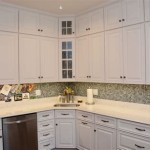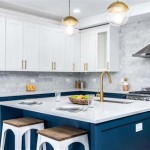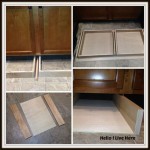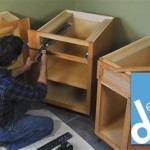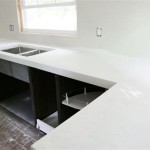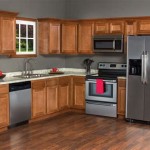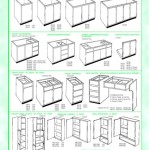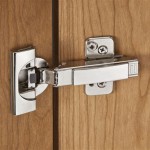How to Add Shelves Under Kitchen Cabinets
Maximizing storage space is a common goal in kitchen design. One effective method for achieving this is by adding shelves under existing kitchen cabinets. This supplemental storage option is particularly useful for frequently used items, offering easy access without sacrificing valuable counter space. This article provides a comprehensive guide to adding shelves under kitchen cabinets, covering materials, tools, installation techniques, and important considerations for a successful project.
Planning and Preparation: Assessing Needs and Selecting Materials
Before commencing any physical work, thorough planning is crucial. The initial step involves evaluating the specific storage needs. Determine what items will be stored on the under-cabinet shelves. Consider the dimensions of these items to establish the required shelf height, depth, and width. Account for clearance beneath the lower edge of the cabinet and above the highest item to be stored. This helps prevent obstructions and ensures ease of use.
Once the storage requirements are defined, the next step is to select appropriate materials. Several factors influence material choice, including aesthetics, durability, and budget. Common material options include:
- Wood: A classic choice, wood offers a warm and traditional aesthetic. Plywood is a cost-effective option, but solid wood provides greater strength and a more refined appearance. Select hardwoods such as maple or oak for durability and resistance to wear and tear. Consider pre-finished wood to simplify the finishing process.
- Metal: Metal shelves, such as stainless steel or powder-coated steel, offer a modern and industrial aesthetic. They are durable, easy to clean, and resistant to moisture. Metal shelves can be purchased pre-fabricated or custom-made to specific dimensions.
- Plastic: Plastic shelves are a lightweight and affordable option. They are resistant to moisture and easy to clean. However, they may not be as durable as wood or metal and are not suitable for heavy items.
- Glass: Glass shelves provide a clean and contemporary look. Tempered glass is recommended for safety and durability. Glass shelves can be paired with metal brackets for a sleek and minimalist design.
In addition to the shelf material, consider the type of support system required. Common options include:
- Brackets: Brackets are a straightforward and versatile option. They are typically made of metal and attach to the underside of the cabinet and support the shelf from below. Choose brackets that are appropriately sized and rated for the weight of the items to be stored on the shelf.
- Suspension Rods: Suspension rods offer a modern and minimalist aesthetic. They attach to the underside of the cabinet and suspend the shelf from above using thin metal rods or cables. This option is suitable for lighter items and provides a clean, unobstructed look.
- Built-in Supports: For a more integrated look, consider building a frame that attaches to the inside of the cabinet and provides support for the shelf. This option requires more advanced woodworking skills but offers a seamless and custom appearance.
After selecting the materials, compile a list of necessary tools, which may include:
- Measuring tape
- Pencil
- Level
- Stud finder (optional, but recommended)
- Drill and drill bits
- Screwdriver
- Saw (if cutting shelves to size)
- Sandpaper (if working with wood)
- Safety glasses
- Dust mask
Obtain all materials and tools before starting the installation process. Ensure that the materials are of high quality and that the tools are in good working order. This will help to ensure a smooth and successful project.
Installation Techniques: Step-by-Step Guide to Secure Shelf Attachment
The installation process typically involves several key steps, ensuring the shelves are securely attached and level. The specific steps may vary depending on the chosen support system, but the general principles remain the same:
- Measure and Mark: Accurately measure and mark the location of the shelf on the underside of the cabinet. Use a level to ensure that the shelf will be horizontal. Consider the height of the items to be stored and ensure that there is adequate clearance beneath the shelf.
- Locate Cabinet Framing: If using brackets, locate the framing within the cabinet to provide a secure attachment point. Use a stud finder to identify the location of studs or other structural members. Mark the location of the studs on the underside of the cabinet. If no framing is accessible, use appropriate drywall anchors.
- Prepare the Mounting Surfaces: Clean the underside of the cabinet to remove any dirt, dust, or grease. This will ensure a strong bond between the brackets and the cabinet surface. If necessary, sand the surface to create a rougher texture for better adhesion.
- Attach the Brackets or Supports: Using screws or other appropriate fasteners, attach the brackets or supports to the underside of the cabinet. Ensure that the brackets are securely fastened and aligned properly. Use a level to verify that the brackets are horizontal. If using suspension rods, ensure they are attached to a secure support point within the cabinet.
- Install the Shelf: Carefully place the shelf onto the brackets or supports. Ensure that the shelf is level and properly aligned. If necessary, use shims to level the shelf. Secure the shelf to the brackets using screws or other appropriate fasteners.
- Test the Shelf: Before loading the shelf with items, test its stability by applying gentle pressure. Ensure that the shelf is securely attached and can support the intended weight. If any instability is detected, reinforce the attachment points or adjust the support system.
When working with wood, pre-drilling pilot holes is highly recommended to prevent splitting. Use a drill bit that is slightly smaller than the diameter of the screws. This will make it easier to drive the screws and prevent damage to the wood. When working with metal, use self-tapping screws or drill pilot holes before attaching the brackets. Ensure that the screws are long enough to penetrate the cabinet framing or support structure adequately.
For cabinets with recessed bottoms, consider using spacers between the brackets and the cabinet surface to create a flush mounting surface. This will provide a more stable and secure attachment point. Also, when installing multiple shelves beneath a single cabinet, maintain consistent spacing between the shelves for a uniform and aesthetically pleasing appearance.
Considerations for Safety and Aesthetics: Enhancing Functionality and Design
Safety and aesthetics are essential considerations when adding shelves under kitchen cabinets. A well-designed and properly installed shelf not only enhances functionality but also complements the overall kitchen design.
Safety Considerations:
- Weight Capacity: Ensure that the shelves and support system are rated for the weight of the items to be stored. Overloading the shelves can lead to collapse and potential injury. Consult the manufacturer's specifications for weight capacity information.
- Secure Attachment: Securely attach the shelves and supports to the cabinet framing or support structure. Loose or unstable shelves can pose a safety hazard. Regularly inspect the shelves for signs of wear or damage and repair as needed.
- Sharp Edges: Be mindful of sharp edges on the shelves or brackets. Use edge banding or other protective measures to prevent accidental cuts or scrapes.
- Clearance: Ensure sufficient clearance beneath the shelves to prevent head injuries or obstructions. Consider the height of the tallest person who will be using the kitchen.
Aesthetic Considerations:
- Material Choice: Select materials that complement the existing kitchen décor. Consider the color, texture, and finish of the cabinets and countertops.
- Shelf Design: Choose a shelf design that enhances the overall aesthetic of the kitchen. Consider the shape, size, and style of the shelves.
- Bracket Design: Select brackets or supports that are visually appealing and complement the shelf design. Consider the color, shape, and finish of the brackets.
- Spacing: Maintain consistent spacing between the shelves for a uniform and aesthetically pleasing appearance. Consider the size and shape of the items to be stored when determining the spacing.
- Finishing: Apply a finish to the shelves that protects the material and enhances its appearance. Consider using paint, stain, or varnish.
For a more integrated look, consider painting the shelves and brackets the same color as the cabinets. This will create a seamless and cohesive design. Alternatively, choose contrasting colors to create a bold and eye-catching effect. When selecting materials, consider the overall style of the kitchen. For a modern kitchen, consider using metal or glass shelves. For a traditional kitchen, consider using wood shelves with decorative brackets. Lighting can also enhance the appearance and functionality of under-cabinet shelves. Consider installing LED strip lights beneath the cabinets to illuminate the shelves and provide additional task lighting.
Adding shelves under kitchen cabinets is a relatively straightforward project that can significantly increase storage space and improve kitchen organization. By carefully planning the project, selecting appropriate materials and tools, and following proper installation techniques, one can successfully add functional and aesthetically pleasing shelves under kitchen cabinets. Remember to prioritize safety throughout the process and regularly inspect the shelves for any signs of wear or damage.

Building Open Shelving Below Existing Cabinets Kitchen Renovation Diy New

Shelf Under Cabinets Sawdust 2 Stitches

How To Raise Your Kitchen Cabinets The Ceiling Wildfire Interiors

10 Simple Ideas To Update Your Kitchen Cabinets Jenna Sue Design

Genius Diy Raising Kitchen Cabinets And Adding An Open Shelf The Crazy Craft Lady

Maximize Kitchen Storage With Under Cabinet Shelves

20 Kitchen Storage Ideas Extra Space
Before After Kitchen Breakfast Nook The House Diaries

Farmhouse Kitchen On A Budget The Reveal Wildfire Interiors Remodel Renovation Home Kitchens

How To Use Kitchen Shelves Balance Looks And Functionality
Related Posts

